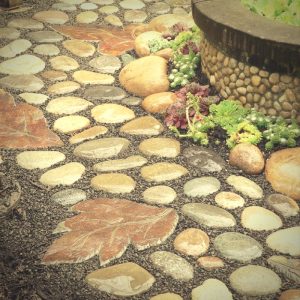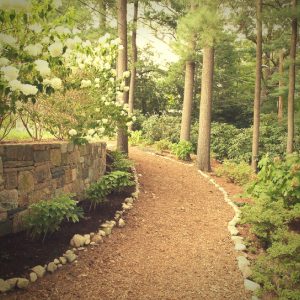Creating paths and walkways are easy when constructed from natural materials. Stone paths and mulch walkways are no maintenance. Rock walkways, bordered with natural plants are very low maintenance. Each of these paths and walkways can be constructed in a short time, with limited resources, and by a single individual, while adding functionality and enjoyment to the property.
Stone Paths
 Stone pathways are designed to accommodate travel from one point to another. Frequent trips to a single destination can create muddy pathways in an established yard during wet weather. Instead of a concrete walkway, create an easy and eye-appealing stone pathway. Use of flat sandstone or flagstone will give the desired results.
Stone pathways are designed to accommodate travel from one point to another. Frequent trips to a single destination can create muddy pathways in an established yard during wet weather. Instead of a concrete walkway, create an easy and eye-appealing stone pathway. Use of flat sandstone or flagstone will give the desired results.
With a can of spray paint, walk in a natural stride from point “A” to point “B”, marking a spot for each step with the paint. From these marks a count can be made for the number of stones necessary. At each spot remove enough grass and soil to place a stone. Use a stone large enough to allow for good footing and some grass to grow over it, but not completely cover the stone. For leveling purposes it is best to add sand to the bottom of the hole before setting the stone.
Be sure the stone is set lower than the blades of the grass mower so the pathway can easily be mowed over. The only maintenance required is to remove excess grass growing over the stone every few years.
Rock Walkways
 Natural rock walkways are very low maintenance and give pleasing eye-appeal. Rather than use “hard” borders that need constant edging, use natural plants for borders. When laying out rock walkways incorporate natural curves if possible. A curve adds character to a walkway, a sense of distance, and the illusion of more space. Use of a garden hose will help lay out gentle curves. If space allows, make the walkway at least 36” wide to accommodate two people walking side-by-side.
Natural rock walkways are very low maintenance and give pleasing eye-appeal. Rather than use “hard” borders that need constant edging, use natural plants for borders. When laying out rock walkways incorporate natural curves if possible. A curve adds character to a walkway, a sense of distance, and the illusion of more space. Use of a garden hose will help lay out gentle curves. If space allows, make the walkway at least 36” wide to accommodate two people walking side-by-side.
Spray the edges of the walkway with paint for a guide. Spray all vegetation within the walkway with a strong weed killer, such as Roundup, being careful to keep any over-spray off adjoining plants. Allow a few days for the herbicide to kill all vegetation growing.
Once all vegetation is dead, apply a layer of heavy weed barrier. Commercial grade barrier is the thickest and best product to use. It is not necessary to remove the dead vegetation from the area. Over the weed barrier, apply at least three inches of river rock, using one half inch to one inch size rock. Larger rock makes walking difficult and smaller gravel will “track”. Level the walkway with a rake.
Instead of using a hard border edging that must be trimmed weekly, use natural plants. Mondo Grass, or Monkey Grass, is an excellent plant for edging and also provides blooms in the fall. It grows 12-16” tall, is dense, not an invasive grass, and grows well in full sun or partial shade. There is a dwarf Mondo Grass that grows only about 4-6” tall.
Along the edge of the weed barrier, plant springs of the Mondo Grass at four inch intervals. Within one growing season, the grass makes a solid dense border for the rock walkway. Trimming is not necessary since mowing can be done right up to the grass edging.
Occasional weeding (by hand or spray) and leveling by raking is the only maintenance needed for this rock walkway. Additional rock may need to be added every 4-5 years.
When installing an inviting walkway in your home, consider adding some lighting to highlight your hard work.
Mulch Walkways
 Walkways in dense shade areas are easily constructed by using natural materials of cypress mulch, wood chips or small pine bark nuggets. A weed barrier material is not necessary as there is minimal vegetation growth. Layering a three inch deep walkway will last several years before additional material is needed. A mulch walkway through heavily shaded, wooded areas are designed for leisurely strolls and enjoyment of nature. A bench placed for resting and sitting quietly is a bonus.
Walkways in dense shade areas are easily constructed by using natural materials of cypress mulch, wood chips or small pine bark nuggets. A weed barrier material is not necessary as there is minimal vegetation growth. Layering a three inch deep walkway will last several years before additional material is needed. A mulch walkway through heavily shaded, wooded areas are designed for leisurely strolls and enjoyment of nature. A bench placed for resting and sitting quietly is a bonus.
River rock and mulch can be purchased in bulk form with delivery for less cost than materials purchased in bags. Contact a local nursery for information on purchasing products in bulk.
Paths and walkways can be designed with very little maintenance required, and can be accomplished in a short period of time. Decide the best design for the purpose, locate the materials and add enjoyment and value to personal property.
The post 3 Walkway Options for a Beautiful Landscape appeared first on All around the house.
from All around the house http://allaroundthe.house/3-walkway-options-beautiful-landscape/
via IFTTT
Comments
Post a Comment